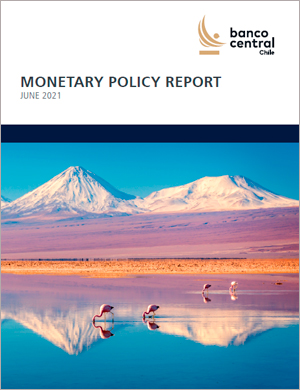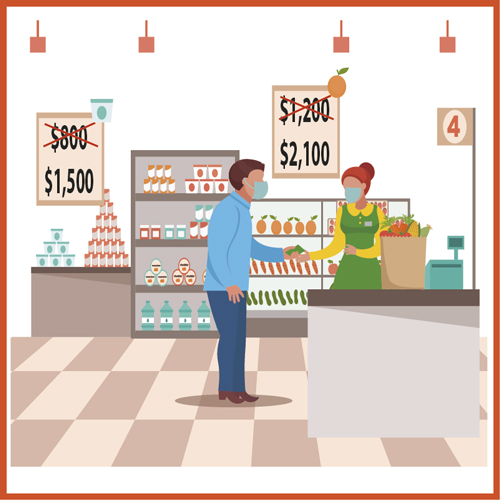Monetary Policy Report June 2021
Monetary Policy Report June 2021

The economic recovery has been a positive surprise during the first months of 2021, reflecting the strong macroeconomic momentum and the agents’ better adaptation to the sanitary constraints. Private consumption has risen strongly, fueled by pension savings withdrawals and massive fiscal transfers. Added to this are the recently approved reforms so that fiscal expansion will significantly exceed the March forecast. The better recent performance combined with the increased spending impulse, in a context of more favorable external conditions, lead to a significant correction in this year’s projected growth. Even with these advances and more positive prospects for recovery, the general perception remains marked by the evolution of infections and quarantines, the significant backwardness of some sectors, the fragilities in the labor market and the persistence of high uncertainty. The local financial market has reacted to these developments, and long rates have risen while their external counterparts have not, the stock market has fallen, and sovereign risk has seen a moderate increase. The higher growth rate expected for 2021 will bring the closing of the wide activity gap caused by the Covid-19 crisis forward, reducing the need for monetary impulse to support the recovery of the economy. Thus, it should begin to moderate sooner than was expected in the last MP Report. This will prevent an increase in inflation —currently around 3.5%— from raising the cost of living and eroding the purchasing power of the households most affected by the crisis. Even so, in the central scenario, the monetary policy rate (MPR) is expected to be held below its neutral level throughout the policy horizon, underpinning a recovery process that will continue to endure significant challenges.
What does this MP Report tell us?

The economy has outpaced expectations, driven by income-support measures for individuals and better adaptation of firms and households to the pandemic context.

However, the recovery has not come to everyone as quickly and there are still groups of people and companies that have been unable to overcome their difficulties.

The economy has outpaced expectations, driven by income-support measures for individuals and better adaptation of firms and households to the pandemic context.
- In the period from January to April this year the economy grew more than expected.
- Although virtually the entire population was quarantined at the end of March, the effect on economic activity was less than at the beginning of the pandemic as this time individuals and businesses were better prepared.
- Consumption continues to grow strongly, spurred by the resources that consumers have obtained from fiscal bonuses and subsidies and pension savings withdrawals. Purchases of durable goods such as cars and technological items have been particularly significant.
- On the business side, most important has been investment in machinery and equipment.

However, the recovery has not come to everyone as quickly and there are still groups of people and companies that have been unable to overcome their difficulties.
- The businesses most severely affected by the social distancing measures, including some services and the construction sector, have had the most difficulties in resuming their activities.
- Small and medium-sized enterprises have struggled the most in adapting their operations to the pandemic context.
- Investment in construction and works is the demand component that is lagging the most.
- Women are among the people facing the most difficulties to go back to work.
- The same is true for people with less education.

The recently–approved massive subsidies will continue to boost consumption, resulting in strong economic growth this year.
- The amounts involved in the extension of the Emergency Family Income and aids to small firms are very significant.
- This extension will mean reaching over 15 million persons.
- Thus, government expenditure in 2021 will be substantial, exceeding its volume of 2020.
- This will lead consumption to grow strongly, but to the extent that companies are unable to stock more products, the increased demand could result in price increases in those goods and services that are in short supply.

With this momentum, there is less need for monetary policy to be as expansionary, so it should begin to moderate in order to prevent inflation from rising
- Higher inflation would drive up the cost of living and reduce purchasing power, which would be especially harmful to those most affected by the pandemic. That is why the Central Bank will do everything in its hands to ensure that inflation does not become a problem.
- While an increase in interest rates would make it more expensive to take out new loans, higher inflation would raise the outstanding UF-indexed loan installments, house rents and some utility payments.
- In any case, monetary policy will remain expansionary for a long time to come.
Presentations
Presentación del Informe de Política Monetaria junio 2021 en el Senado.
Conferencia de prensa. Informe de Política Monetaria junio 2021
- Presidente Mario Marcel, Presentación IPoM junio 2021 en el Senado
- Governor Mario Marcel, Monetary Policy Report June 2021 in Icare
- Vicepresidente Joaquín Vial, Presentación IPoM Junio 2021 en red de Ingenieros Comerciales de Chile
- Consejero Pablo Garcia, Presentación IPoM Junio 2021 a analistas de mercado – Ibiuna – Global Source Partners
- Consejera Rosanna Costa, Presentación IPoM Junio 2021 Universidad Católica
- Vicepresidente Joaquín Vial, Presentación IPoM Junio 2021 en Cámara Chilena de la Construcción de Copiapó, el Diario de Atacama
- Consejera Rosanna Costa, Presentación IPoM Junio 2021 Universidad Autónoma
